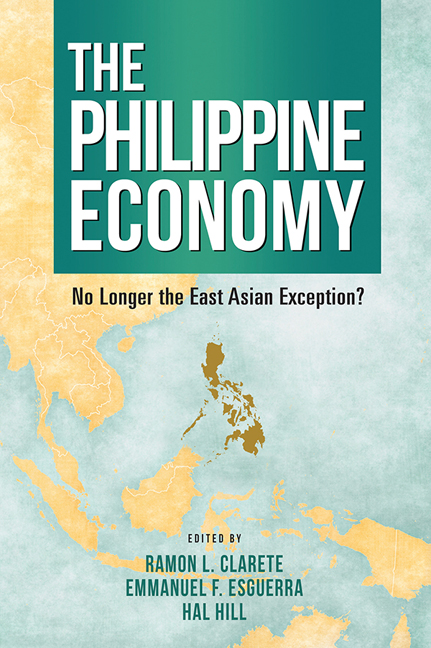Book contents
- Frontmatter
- Contents
- List of Figures
- List of Tables
- Foreword by Arsenio M. Balisacan
- Preface
- About the Contributors
- 1 The Philippine Economy: An Overview
- 2 Economic Growth and Poverty Reduction
- 3 Infrastructure and Urbanization
- 4 Education and Training
- 5 Universal Health Coverage, Health Security and Resilient Health Systems
- 6 Environmental Resources, Shocks and National Well-Being
- 7 Energy: Power Security and Competitiveness
- 8 Development Finance
- 9 Governance and Institutions
- Index
3 - Infrastructure and Urbanization
Published online by Cambridge University Press: 12 February 2019
- Frontmatter
- Contents
- List of Figures
- List of Tables
- Foreword by Arsenio M. Balisacan
- Preface
- About the Contributors
- 1 The Philippine Economy: An Overview
- 2 Economic Growth and Poverty Reduction
- 3 Infrastructure and Urbanization
- 4 Education and Training
- 5 Universal Health Coverage, Health Security and Resilient Health Systems
- 6 Environmental Resources, Shocks and National Well-Being
- 7 Energy: Power Security and Competitiveness
- 8 Development Finance
- 9 Governance and Institutions
- Index
Summary
Infrastructure is a driver of growth. It provides energy, water and other production inputs. It connects products with markets, and labour with jobs. Infrastructure enables access to education, healthcare, housing and other services that let communities thrive and be more resilient.
Investments in infrastructure promote economic activities that generate employment, increase household incomes and reduce poverty. According to an estimate of the World Economic Forum (WEF), every dollar spent on a capital project (in utilities, energy, transport, waste management, flood prevention, telecommunications) generates a 5'25 per cent economic return. Clearly, the lack of infrastructure is a constraint to growth and poverty reduction (Llanto 2015).
Ideally, infrastructure keeps pace with demand even as demand itself is catalysed by infrastructure in a virtuous spiral of growth. Not surprisingly, the biggest demand for infrastructure is in urban areas, where population and activities are concentrated. With scale and agglomeration economies, these areas are often associated with innovation and productivity, economic growth, employment generation and higher (than rural) family incomes. This is consistent with the Philippine experience, as the largest urban centre, Metro Manila, is the primary venue for poverty reduction in the country. It is useful, therefore, to view infrastructure in the context of the country's network of settlements, keeping in mind that rural areas are inextricable elements of this network (e.g., as agricultural productivity rises, surplus labour migrates to urban-based industries and services which, in turn, are fuelled by rising worker incomes as industrial productivity also rises).
Based on public consultations on the aspirations of Filipinos, a 2040 vision for the state of infrastructure and urban development may be stated as follows:
Cities are working as engines of economic growth and venues of poverty reduction, with infrastructure that provides quality services and affordable housing, and forms efficient and connected networks of sustainable communities.
This chapter looks at infrastructure (including housing) in the Philippines as it relates to the vision from two analytical perspectives. The first is a summary of how the infrastructure sector has performed. It covers both the national and local (metro/region) dimensions. Performance indicators, benchmarks and targets are identified. The second is a complementary and broader analysis of infrastructure from the perspective of urbanization, or, broadly speaking, the settlements network. It looks at how population is distributed throughout the country and how this affects the location of infrastructure, as well as overall urban and regional development.
- Type
- Chapter
- Information
- The Philippine EconomyNo Longer The East Asian Exception?, pp. 112 - 150Publisher: ISEAS–Yusof Ishak InstitutePrint publication year: 2018



